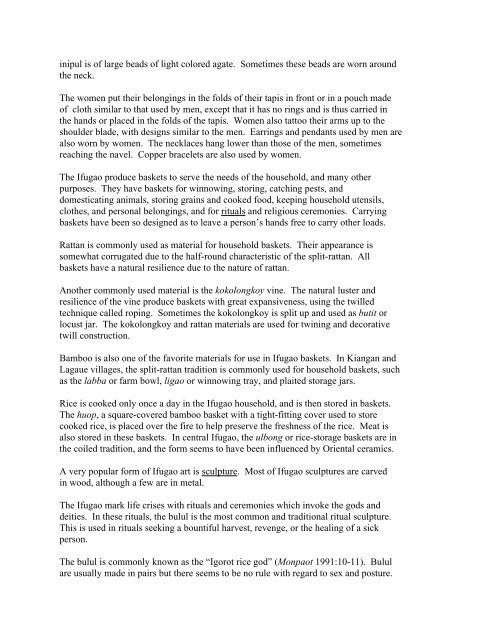“Ifugao” refers to the group of people living in Ifugao province ...
“Ifugao” refers to the group of people living in Ifugao province ...
“Ifugao” refers to the group of people living in Ifugao province ...
You also want an ePaper? Increase the reach of your titles
YUMPU automatically turns print PDFs into web optimized ePapers that Google loves.
<strong>in</strong>ipul is <strong>of</strong> large beads <strong>of</strong> light colored agate. Sometimes <strong>the</strong>se beads are worn around<br />
<strong>the</strong> neck.<br />
The women put <strong>the</strong>ir belong<strong>in</strong>gs <strong>in</strong> <strong>the</strong> folds <strong>of</strong> <strong>the</strong>ir tapis <strong>in</strong> front or <strong>in</strong> a pouch made<br />
<strong>of</strong> cloth similar <strong>to</strong> that used by men, except that it has no r<strong>in</strong>gs and is thus carried <strong>in</strong><br />
<strong>the</strong> hands or placed <strong>in</strong> <strong>the</strong> folds <strong>of</strong> <strong>the</strong> tapis. Women also tat<strong>to</strong>o <strong>the</strong>ir arms up <strong>to</strong> <strong>the</strong><br />
shoulder blade, with designs similar <strong>to</strong> <strong>the</strong> men. Earr<strong>in</strong>gs and pendants used by men are<br />
also worn by women. The necklaces hang lower than those <strong>of</strong> <strong>the</strong> men, sometimes<br />
reach<strong>in</strong>g <strong>the</strong> navel. Copper bracelets are also used by women.<br />
The <strong>Ifugao</strong> produce baskets <strong>to</strong> serve <strong>the</strong> needs <strong>of</strong> <strong>the</strong> household, and many o<strong>the</strong>r<br />
purposes. They have baskets for w<strong>in</strong>now<strong>in</strong>g, s<strong>to</strong>r<strong>in</strong>g, catch<strong>in</strong>g pests, and<br />
domesticat<strong>in</strong>g animals, s<strong>to</strong>r<strong>in</strong>g gra<strong>in</strong>s and cooked food, keep<strong>in</strong>g household utensils,<br />
clo<strong>the</strong>s, and personal belong<strong>in</strong>gs, and for rituals and religious ceremonies. Carry<strong>in</strong>g<br />
baskets have been so designed as <strong>to</strong> leave a person’s hands free <strong>to</strong> carry o<strong>the</strong>r loads.<br />
Rattan is commonly used as material for household baskets. Their appearance is<br />
somewhat corrugated due <strong>to</strong> <strong>the</strong> half-round characteristic <strong>of</strong> <strong>the</strong> split-rattan. All<br />
baskets have a natural resilience due <strong>to</strong> <strong>the</strong> nature <strong>of</strong> rattan.<br />
Ano<strong>the</strong>r commonly used material is <strong>the</strong> kokolongkoy v<strong>in</strong>e. The natural luster and<br />
resilience <strong>of</strong> <strong>the</strong> v<strong>in</strong>e produce baskets with great expansiveness, us<strong>in</strong>g <strong>the</strong> twilled<br />
technique called rop<strong>in</strong>g. Sometimes <strong>the</strong> kokolongkoy is split up and used as butit or<br />
locust jar. The kokolongkoy and rattan materials are used for tw<strong>in</strong><strong>in</strong>g and decorative<br />
twill construction.<br />
Bamboo is also one <strong>of</strong> <strong>the</strong> favorite materials for use <strong>in</strong> <strong>Ifugao</strong> baskets. In Kiangan and<br />
Lagaue villages, <strong>the</strong> split-rattan tradition is commonly used for household baskets, such<br />
as <strong>the</strong> labba or farm bowl, ligao or w<strong>in</strong>now<strong>in</strong>g tray, and plaited s<strong>to</strong>rage jars.<br />
Rice is cooked only once a day <strong>in</strong> <strong>the</strong> <strong>Ifugao</strong> household, and is <strong>the</strong>n s<strong>to</strong>red <strong>in</strong> baskets.<br />
The huop, a square-covered bamboo basket with a tight-fitt<strong>in</strong>g cover used <strong>to</strong> s<strong>to</strong>re<br />
cooked rice, is placed over <strong>the</strong> fire <strong>to</strong> help preserve <strong>the</strong> freshness <strong>of</strong> <strong>the</strong> rice. Meat is<br />
also s<strong>to</strong>red <strong>in</strong> <strong>the</strong>se baskets. In central <strong>Ifugao</strong>, <strong>the</strong> ulbong or rice-s<strong>to</strong>rage baskets are <strong>in</strong><br />
<strong>the</strong> coiled tradition, and <strong>the</strong> form seems <strong>to</strong> have been <strong>in</strong>fluenced by Oriental ceramics.<br />
A very popular form <strong>of</strong> <strong>Ifugao</strong> art is sculpture. Most <strong>of</strong> <strong>Ifugao</strong> sculptures are carved<br />
<strong>in</strong> wood, although a few are <strong>in</strong> metal.<br />
The <strong>Ifugao</strong> mark life crises with rituals and ceremonies which <strong>in</strong>voke <strong>the</strong> gods and<br />
deities. In <strong>the</strong>se rituals, <strong>the</strong> bulul is <strong>the</strong> most common and traditional ritual sculpture.<br />
This is used <strong>in</strong> rituals seek<strong>in</strong>g a bountiful harvest, revenge, or <strong>the</strong> heal<strong>in</strong>g <strong>of</strong> a sick<br />
person.<br />
The bulul is commonly known as <strong>the</strong> “Igorot rice god” (Monpaot 1991:10-11). Bulul<br />
are usually made <strong>in</strong> pairs but <strong>the</strong>re seems <strong>to</strong> be no rule with regard <strong>to</strong> sex and posture.
















